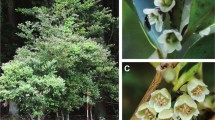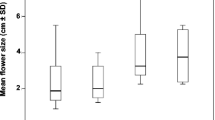Summary
Selection favouring an outcrossing plant's ability to sire seeds generally promotes floral characters that increase (1) the frequency of pollinator visits, (2) the number of pollen grains dispersed to other plants by each pollinator and (3) the probability of a pollen grain successfully fertilizing an ovule after reaching a stigma. Flowers influence pollen dispersal and fertilization probabilities by determining the pattern of pollen removal during a series of visits (dispensing schedule). We model male reproductive success to identify optimal dispensing schedules, which characteristically involve monotonic increases in the proportion of remaining pollen removed during successive visits. These schedules balance the benefits of restricted removal, which counteracts the diminishing returns associated with animal pollination (e.g. pollinator grooming, local mate competition), with the advantages of increased removal to avoid time-dependent losses in fertilization ability (e.g. pollen precedence, declining viability). Because pollinator availability mediates this balance, the most effective dispensing schedule allows dynamic adjustment of removal to the prevailing frequency of visits experienced by individual plants. As an example of such dynamic removal we demonstrate that the dispensing mechanism ofLupinus sericeus flowers allows facultative adjustment of removal to the interval between visits. Because optimal control of pollen removal can increase a plant's mating opportunities by an order of magnitude, dispensing mechanisms should be a common component of floral design.
Similar content being viewed by others
References
Bell, G. (1985) On the function of flowers.Proc. R. Soc. London, B 224 223–65.
Buchmann, S.L. (1983) Buzz pollination in angiosperms. InHandbook of experimental pollination biology (C.E. Jones and R.J. Little, eds), pp. 73–113. Van Nostrand Reinhold, New York.
Cartar, R.V. and Dill, L.M. (1990) Why are bumble bees risk-sensitive foragers?Behav. Ecol. Sociobiol. 26 121–7.
Charnov, E.L. (1982)The Theory of Sex Allocation. Princeton University Press, Princeton, NJ.
Cibula, D.A. and Zimmerman, M. (1984) The effect of plant density on departure decisions: testing the marginal value theorem using bumblebees andDelphinium nelsonii.Oikos 43 154–8.
Cruden, R.W., Hermann, S.M. and Peterson, S. (1983) Patterns of nectar production and plant—pollinator coevolution. InThe biology of nectaries (B. Bentley and T.S. Elias, eds), pp. 80–125. Columbia University Press, New York.
Dajoz, I., Till-Bottraud, I. and Gouyon, P.H. (1991) Evolution of pollen morphology.Science 253 66–8.
Darwin, C.R. (1877)The Different Forms of Flowers on Plants of the Same Species. Murray, London.
Dobson, H.E.M. (1987) Role of flower and pollen aromas in host-plant recognition by solitary bees.Oecologia 72 618–23.
Dunn, D.B. (1956) The breeding system ofLupinus, groupMicranthi.Am. Midl. Nat. 55 443–72.
Epperson, B.K. and Clegg, M.T. (1987) First-pollination primacy and pollen selection in the morning glory,Ipomoea purpurea.Heredity 58 5–14.
Fægri, K. and van der Pijl, L. (1979)The Principles of Pollination Ecology, 3rd edn. Pergamon, Oxford.
Feinsinger, P. and Tiebout, H.M. (1991) Competition among plants sharing hummingbird pollinators: laboratory experiments on a mechanism.Ecology 72 1946–52.
Galen, C. (1992) Pollen dispersal dynamics in an alpine wildflower,Polemonium viscosum.Evolution 46 1043–51.
Galen, C. and Stanton, M.L. (1989) Bumble bee pollination and floral morphology: factors influencing pollen dispersal in the alpine sky pilot,Polemonium viscosum (Polemoniaceae).Am. J. Bot. 76, 419–26.
Galen, C., Zimmer, K.A. and Newport, M.E. (1987) Pollination in floral scent morphs ofPolemonium viscosum: a mechanism for disruptive selection on flower size.Evolution 41 599–606
Graham, S.W. and Barrett, S.C.H. (1990) Pollen precedence inEichhornia paniculata: a tristylous species.Am. J. Bot. 77 (suppl.), 54–5.
Harder, L.D. (1990a) Pollen removal by bumble bees and its implications for pollen dispersal.Ecology 71, 1110–25.
Harder, L.D. (1990b) Behavioral responses by bumble bees to variation in pollen availability.Oecologia 85 41–7.
Harder, L.D. and Barclay, R.M.R. (In press) The functional significance of poricidal anthers and buzz pollination: controlled pollen removal fromDodecatheon Funct. Ecol.
Harder, L.D. and Barrett, S.C.H. (1993) Pollen removal from tristylousPontederia cordata: effects of anther position and pollinator specialization.Ecology 74 1059–72.
Harder, L.D. and Thomson, J.D. (1989) Evolutionary options for maximizing pollen dispersal of animal-pollinated plants.Am. Nat. 133 323–72.
Hoekstra, F.A. (1983) Physiological evolution in angiosperm pollen: possible role of pollen vigour. InPollen: biology and implications for plant breeding (D.L. Mulcahy and E. Ottaviano, eds), pp. 35–41. Elsevier, New York.
Hoekstra, F.A. and Bruinsma, J. (1975a) Respiration and vitality of binucleate and trinucleate pollen.Physiol. Plant. 34 221–5.
Hoekstra, F.A. and Bruinsma, J. (1975b) Viability of Compositae pollen: germinationin vitro and influences of climatic conditions during dehiscence.Zeit. Pflanzenphysiol. 76 36–43.
Juncosa, A.M. and Webster, B.D. (1989) Pollination inLupinus nanus subsp.latifolius (Leguminosae).Am. J. Bot. 76 59–66.
Kadmon, R. (1992) Dynamics of forager arrivals and nectar renewal in flowers ofAnchusa strigosa.Oecologia 92 552–5.
Klinkhamer, P.G.L., de Jong, T.J. and Wesselingh, R.A. (1991) Implications of differences between hermaphrodite and female flowers for attractiveness to pollinators and seed production.Netherlands J. Zool. 41 130–43.
Le Buhn, G. and Anderson, G.J. (In press) Anther tripping and pollen dispensing inBarberis thumbergii. Am. Midl. Nat.
Lloyd, D.G. (1984) Gender allocations in outcrossing cosexual plants. InPerspectives on plant population ecology (R. Dirzo and J. Sarukhán, eds), pp. 277–300. Sinauer Associates, Sunderland, MA.
Lloyd, D.G. and Yates, J.M.A. (1982) Intrasexual selection and the segregation of pollen and stigmas in hermaphrodite plants, exemplified byWahlenbergia albomarginata (Campanulaceae).Evolution 36 903–13.
Lunau, K. (1991) Innate flower recognition in bumblebees (Bombus terrestris, B. lucorum; Apidae): optical signals from stamens as landing reaction releasers.Ethology 88 203–14.
Macior, L.W. (1982) Plant community and pollinator dynamics in the evolution of pollination mechanisms inPedicularis (Scrophulariaceae). InPollination and evolution (J.A. Armstrong and A.J. Richards, eds), pp. 29–45. Royal Botanic Gardens, Sydney.
Marden, J.H. and Waddington, K.D. (1981) Floral choices by honeybees in relation to the relative distances to flowers.Physiol. Entomol. 6, 431–5.
Marshall, D.L. and Ellstrand, N.C. (1985) Proximal causes of multiple paternity in wild radish,Raphanus sativus.Am. Nat. 126, 596–605.
Martinez del Rio, C. and Eguiarte, L.E. (1987) The effect of nectar availability on the foraging behavior of the stingless beeTrigona testacea.Southwest. Nat. 32 313–19.
Montgomerie, R.D. (1984) Nectar extraction by hummingbirds: response to different floral characters.Oecologia 63 229–36.
Mulcahy, D.L. and Mulcahy, G.B. (1987) The effects of pollen competition.Am. Sci. 75 44–50.
Proctor, M. and Yeo, P. (1973)The Pollination of Flowers. Collins, London.
Simpson, B.B. and Neff, J.L. (1983) Evolution and diversity of flower rewards. InHandbook of experimental pollination biology (C.E. Jones and R.J. Little, eds), pp. 142–59. Van Nostrand Reinhold, New York.
Snow, A.A. (1986) Evidence for and against pollen tube competition in natural populations. InBiotechnology and ecology of pollen (D.L. Mulcahy, G.B. Mulcahy and E. Ottaviano, eds), pp. 405–410. Springer-Verlag, New York.
Snow, A.A. and Spira, T.P. (1991) Pollen vigour and the potential for sexual selection in plants.Nature 352, 796–7.
Stanton, M.L., Snow, A.A. and Handel, S.N. (1986) Floral evolution: attractiveness to pollinators increases male fitness.Science 232, 1625–7.
Thomson, J.D. (1986) Pollen transport and deposition by bumble bees inErythronium: influences of floral nectar and bee grooming.J. Ecol. 74, 329–41.
Thomson, J.D. and Thomson, B.A. (1992) Pollen presentation and viability schedules in animal-pollinated plants: consequences for reproductive success. InEcology and evolution of plant reproduction (R. Wyatt, ed.), pp. 1–24. Chapman & Hall, New York.
Thomson, J.D., McKenna, M.A. and Cruzan, M.B. (1989) Temporal patterns of nectar and pollen production inAralia hispida: implications for reproductive success.Ecology 70, 1061–8.
Wainwright, C.M. (1978) The floral biology and pollination ecology of two desert lupines.Bull. Torrey Bot. Club 105, 24–38.
Young, H.J. and Stanton, M.L. (1990) Influences of floral variation on pollen removal and seed production in wild radish.Ecology 71, 536–48.
Zimmerman, M. (1981) Optimal foraging, plant density and the marginal value theorem.Oecologia 49, 148–53.
Author information
Authors and Affiliations
Rights and permissions
About this article
Cite this article
Harder, L.D., Wilson, W.G. Floral evolution and male reproductive success: Optimal dispensing schedules for pollen dispersal by animal-pollinated plants. Evol Ecol 8, 542–559 (1994). https://doi.org/10.1007/BF01238257
Issue Date:
DOI: https://doi.org/10.1007/BF01238257




